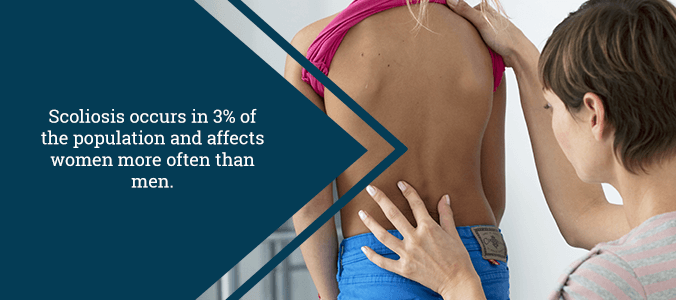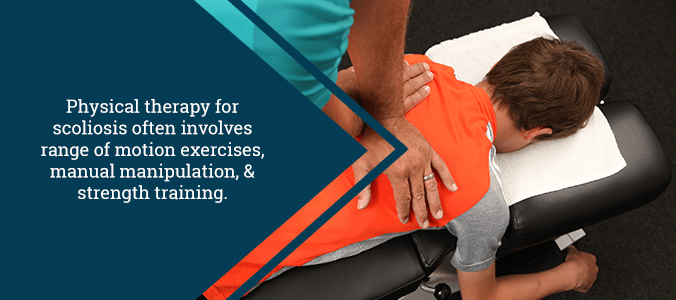Goals of Physical Therapy for Scoliosis
Scoliosis is a condition that affects the normal curvature of the spine. Usually, this most visibly means changes in a person’s overall posture and trunk alignment. This condition results in the spine turning from side-to-side in most cases. Notably, scoliosis may occur at any time, whether it be during adolescence or later in the patient’s lifespan. That being said, doctors will usually detect the condition during adolescence.
Scoliosis affects roughly 3% of the population and usually occurs in women more often than in men. Cases may vary from mild to quite severe, which of course means that the treatments for the condition vary wildly. Some cases may require surgery, while others may find that more conservative treatments are all they need. Determining which category you fall under requires taking multiple variables into consideration—usually something a medical professional does for you. The best treatment for scoliosis is most often a multifaceted approach. Patients with the best outcomes tend to lean on disciplines ranging from orthopedic surgeons, general physicians, and physical therapists.

Scoliosis: A Further Look
Medical communities usually define scoliosis as a sideways curvature of the spine with some degree of rotation. Patients cannot simply address these problems through posture correction alone. Under x-ray imaging, the spine may appear as an “s” or “c” in shape. Medical experts assess the severity of this condition by measuring the angle of the curvature (Cobb angle). For a scoliosis diagnosis, a Cobb angle of at least 10 degrees must be present in the patient.
The most common form of scoliosis occurs in adolescents and is known as adolescent idiopathic scoliosis (AIS). Patients with AIS fall between the ages of 10 and 18. Additionally, the term “idiopathic” essentially means that the cause of the condition is not verifiable. That being said, most patients with AIS have at least some presence of scoliosis in their family medical history.
Other common forms of the condition include:
- Neuromuscular Scoliosis: As the name suggests, this form of scoliosis has its hand in the nervous system through some way or another. Perhaps the patient has muscular dystrophy or cerebral palsy. Such conditions weaken the muscles that support the spine, which may lead to this form of scoliosis.
- Congenital Scoliosis:Congenital conditions begin at some point during a baby’s development. Specifically, something goes awry with the way the baby’s bones form during the early portion of the process.
- Syndromic Scoliosis: Syndromes such as Ehlers-Danlos and Marfan show strong correlations with early onset scoliosis. Other connective tissue problems, as well as neurofibromatosis, are known to have similar relationships.
How Can I Tell If I Have Scoliosis?
Believe it or not, scoliosis usually does not come with painful symptoms. The condition becomes painful when it affects surrounding areas via its unnatural curvature. So, your spine doesn’t hurt because of the curve; instead, the muscles and joints in adjacent spaces do. More negative symptoms of scoliosis lead to abnormal posture, alignment, movement, and pain. Additionally, the unnatural curvature causes spine-supporting muscles to overcompensate for the curve, leading to structural imbalance. This often causes a loss of strength and range of motion.
One of the most common noticeable symptoms with the condition is general unevenness throughout the body. It is not uncommon for one shoulder to be higher than the other, one hip to be higher than the other, or for the waistline to be uneven. Most patients note that there is simply a general feeling of misalignment across both sides of the body.
Pain usually occurs with specific motions, and again, manifests in areas around the spinal curvature. The goal of physical therapy is two-fold: 1) to alleviate these symptoms and restore patient functionality and 2) to do so without relying on surgical procedures. Of course, sometimes surgery and physical therapy go hand-in-hand, with one not being a substitute for the other. It all depends on your situation and you should always communicate with your doctor to understand where your chips fall.

How Does Physical Therapy Help Scoliosis Patients?
Usually, physical therapy treatment options divide into three categories: surgery, bracing, and physical therapy. Of course, there are always more things in between, but this is a good general set to start with. What treatment plan your doctor will choose for you will depend on a variety of factors, but they will always think of your specific needs first.
The good thing about physical therapy is that it is relevant during all phases of the condition. It doesn’t matter if you are in the bracing stage, or if you have recently had surgery. Physical therapy almost always has an answer no matter what stage of scoliosis you sit in. Depending on where you are at with your condition, your physical therapist will being to tailor together an individualized plan that coincides with the severity of your case. Physical therapy treatments for the condition include:
- Range of Motion Exercises: Depending on the nature of your case, your physical therapist will provide you with range of motion treatment guidance that will help address the functional limitations of your scoliosis.
- Manual Therapy:Physical therapists also restore functionality to joints, muscles, and other soft tissues that have been affected by your scoliosis. They will often use their own two hands to help retrain your body into performing healthier movement patterns.
- Strength Training:Your physical therapist will return your core strength to normal, as well as any other adjacent muscles near the affected area. Other areas include the hips, shoulders, head, and feet.
Of course, these are just to name a few subsets of physical therapy—there are obviously many more. Your physical therapist will work with you to determine which approach is the most relevant to your specific case. Because of this, one of the best tools in your arsenal is scoliosis education.

Schroth Method
Also worthy of mention, the Schroth Method is a nonsurgical approach for scoliosis treatment. This school of thought originates from exercises that the physical therapist customizes for each patient to return their specific curvatures back to a neutral position. The goal of the Schroth Method is to lengthen and stabilize the spine, while also addressing the rotation that scoliosis causes. Typically, the Schroth Method achieves this by:
- Breathing Exercises
- Posture Awareness
- Muscular Symmetry Restoration
- Posture Alignment Restoration
This approach to physical therapy will always cause visible improvement in patients with scoliosis. Though the length of the program is variable, the Schroth Method typically consists of five to twenty sessions. Back in the 1800s, these sessions would last for a few hours and were rigidly set as part of a daily routine. In modern times, these programs are much less intense and the sessions are shorter. To compensate for this, the sessions are instead spread out over a longer period of time. Today, sessions using the Schroth Method by contrast last anywhere from 30 minutes to an hour. Of course, the length and frequency of the sessions will always depend on the patient’s stamina as well as the severity of their case.
Are you currently suffering from the symptoms of scoliosis? If so, contact us at your earliest convenience at (855) 220-5966. Dr. Jason E. Lowenstein is very well-versed in both surgical and nonsurgical treatments of scoliosis curves. Dr. Lowenstein will always put you on a plan that best suits your needs so you can rest assured that you are receiving the best care for your individual case.
